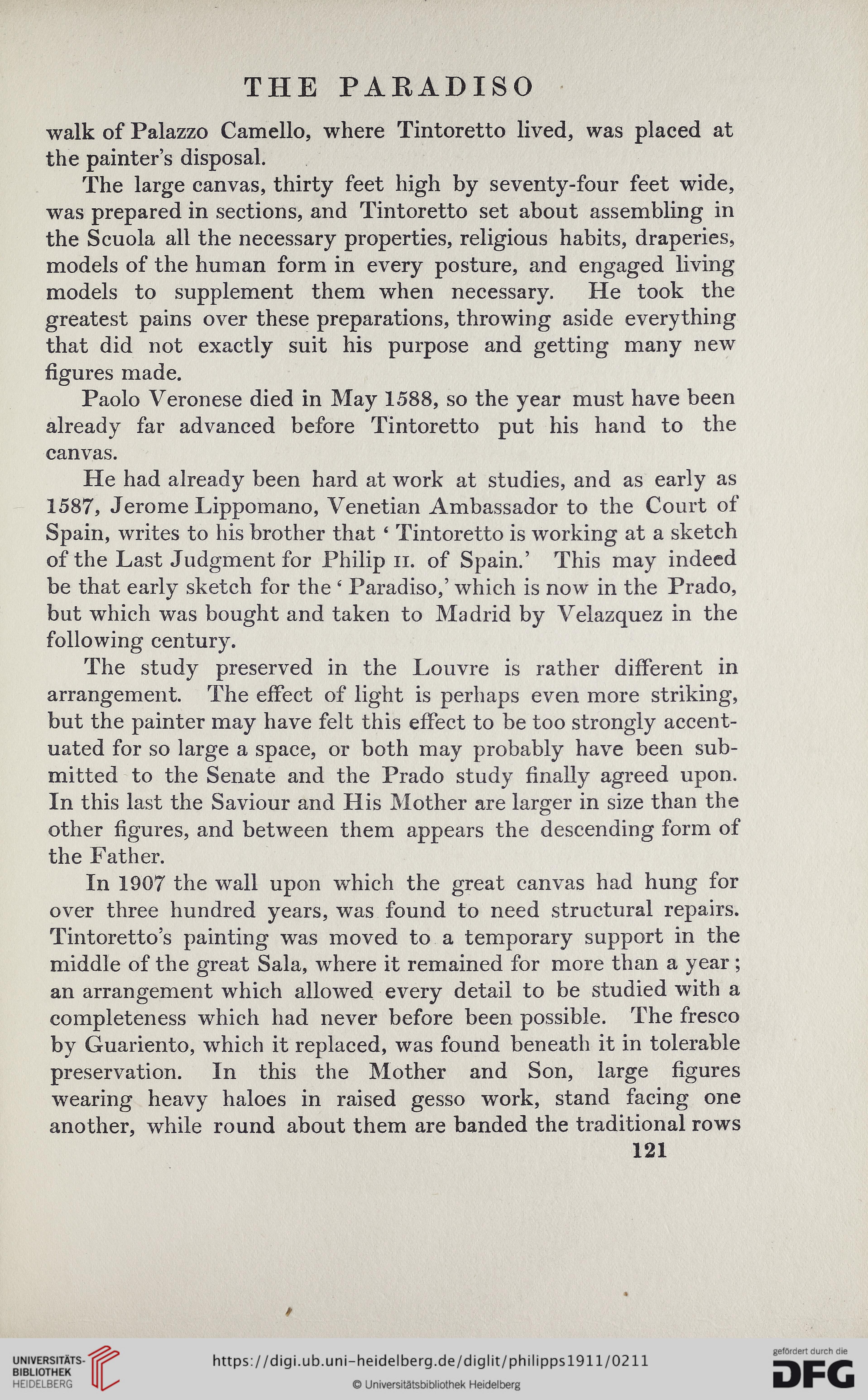THE PARADISO
walk of Palazzo Camello, where Tintoretto lived, was placed at
the painter’s disposal.
The large canvas, thirty feet high by seventy-four feet wide,
was prepared in sections, and Tintoretto set about assembling in
the Scuola all the necessary properties, religious habits, draperies,
models of the human form in every posture, and engaged living
models to supplement them when necessary. He took the
greatest pains over these preparations, throwing aside everything
that did not exactly suit his purpose and getting many new
figures made.
Paolo Veronese died in May 1588, so the year must have been
already far advanced before Tintoretto put his hand to the
canvas.
He had already been hard at work at studies, and as early as
1587, Jerome Lippomano, Venetian Ambassador to the Court of
Spain, writes to his brother that ‘ Tintoretto is working at a sketch
of the Last Judgment for Philip n. of Spain.’ This may indeed
be that early sketch for the ‘ Paradiso,’ which is now in the Prado,
but which was bought and taken to Madrid by Velazquez in the
following century.
The study preserved in the Louvre is rather different in
arrangement. The effect of light is perhaps even more striking,
but the painter may have felt this effect to be too strongly accent-
uated for so large a space, or both may probably have been sub-
mitted to the Senate and the Prado study finally agreed upon.
In this last the Saviour and His Mother are larger in size than the
other figures, and between them appears the descending form of
the Father.
In 1907 the wall upon which the great canvas had hung for
over three hundred years, was found to need structural repairs.
Tintoretto’s painting was moved to a temporary support in the
middle of the great Sala, where it remained for more than a year;
an arrangement which allowed every detail to be studied with a
completeness which had never before been possible. The fresco
by Guariento, which it replaced, was found beneath it in tolerable
preservation. In this the Mother and Son, large figures
wearing heavy haloes in raised gesso work, stand facing one
another, while round about them are banded the traditional rows
121
walk of Palazzo Camello, where Tintoretto lived, was placed at
the painter’s disposal.
The large canvas, thirty feet high by seventy-four feet wide,
was prepared in sections, and Tintoretto set about assembling in
the Scuola all the necessary properties, religious habits, draperies,
models of the human form in every posture, and engaged living
models to supplement them when necessary. He took the
greatest pains over these preparations, throwing aside everything
that did not exactly suit his purpose and getting many new
figures made.
Paolo Veronese died in May 1588, so the year must have been
already far advanced before Tintoretto put his hand to the
canvas.
He had already been hard at work at studies, and as early as
1587, Jerome Lippomano, Venetian Ambassador to the Court of
Spain, writes to his brother that ‘ Tintoretto is working at a sketch
of the Last Judgment for Philip n. of Spain.’ This may indeed
be that early sketch for the ‘ Paradiso,’ which is now in the Prado,
but which was bought and taken to Madrid by Velazquez in the
following century.
The study preserved in the Louvre is rather different in
arrangement. The effect of light is perhaps even more striking,
but the painter may have felt this effect to be too strongly accent-
uated for so large a space, or both may probably have been sub-
mitted to the Senate and the Prado study finally agreed upon.
In this last the Saviour and His Mother are larger in size than the
other figures, and between them appears the descending form of
the Father.
In 1907 the wall upon which the great canvas had hung for
over three hundred years, was found to need structural repairs.
Tintoretto’s painting was moved to a temporary support in the
middle of the great Sala, where it remained for more than a year;
an arrangement which allowed every detail to be studied with a
completeness which had never before been possible. The fresco
by Guariento, which it replaced, was found beneath it in tolerable
preservation. In this the Mother and Son, large figures
wearing heavy haloes in raised gesso work, stand facing one
another, while round about them are banded the traditional rows
121




